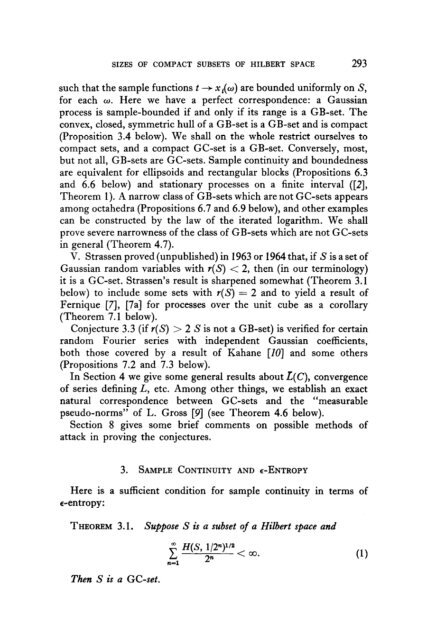On the Characters and the Plancherel Formula of Nilpotent Groups ...
On the Characters and the Plancherel Formula of Nilpotent Groups ...
On the Characters and the Plancherel Formula of Nilpotent Groups ...
You also want an ePaper? Increase the reach of your titles
YUMPU automatically turns print PDFs into web optimized ePapers that Google loves.
SIZES OF COMPACT SUBSETS OF HILBERT SPACE 293<br />
such that <strong>the</strong> sample functions t --+ x1(o) are bounded uniformly on S,<br />
for each w. Here we have a perfect correspondence: a Gaussian<br />
process is sample-bounded if <strong>and</strong> only if its range is a GB-set. The<br />
convex, closed, symmetric hull <strong>of</strong> a GB-set is a GB-set <strong>and</strong> is compact<br />
(Proposition 3.4 below). We shall on <strong>the</strong> whole restrict ourselves to<br />
compact sets, <strong>and</strong> a compact GC-set is a GB-set. Conversely, most,<br />
but not all, GB-sets are GC-sets. Sample continuity <strong>and</strong> boundedness<br />
are equivalent for ellipsoids <strong>and</strong> rectangular blocks (Propositions 6.3<br />
<strong>and</strong> 6.6 below) <strong>and</strong> stationary processes on a finite interval ([2],<br />
Theorem 1). A narrow class <strong>of</strong> GB-sets which are not GC-sets appears<br />
among octahedra (Propositions 6.7 <strong>and</strong> 6.9 below), <strong>and</strong> o<strong>the</strong>r examples<br />
can be constructed by <strong>the</strong> law <strong>of</strong> <strong>the</strong> iterated logarithm. We shall<br />
prove severe narrowness <strong>of</strong> <strong>the</strong> class <strong>of</strong> GB-sets which are not GC-sets<br />
in general (Theorem 4.7).<br />
V. Strassen proved (unpublished) in 1963 or 1964 that, if S is a set <strong>of</strong><br />
Gaussian r<strong>and</strong>om variables with r(S) < 2, <strong>the</strong>n (in our terminology)<br />
it is a GC-set. Strassen’s result is sharpened somewhat (Theorem 3.1<br />
below) to include some sets with r(S) = 2 <strong>and</strong> to yield a result <strong>of</strong><br />
Fernique [7], [7a] for processes over <strong>the</strong> unit cube as a corollary<br />
(Theorem 7.1 below).<br />
Conjecture 3.3 (if r(S) > 2 S is not a GB-set) is verified for certain<br />
r<strong>and</strong>om Fourier series with independent Gaussian coefficients,<br />
both those covered by a result <strong>of</strong> Kahane [IO] <strong>and</strong> some o<strong>the</strong>rs<br />
(Propositions 7.2 <strong>and</strong> 7.3 below).<br />
In Section 4 we give some general results about E(C), convergence<br />
<strong>of</strong> series defining L, etc. Among o<strong>the</strong>r things, we establish an exact<br />
natural correspondence between GC-sets <strong>and</strong> <strong>the</strong> “measurable<br />
pseudo-norms” <strong>of</strong> L. Gross [9] (see Theorem 4.6 below).<br />
Section 8 gives some brief comments on possible methods <strong>of</strong><br />
attack in proving <strong>the</strong> conjectures.<br />
3. SAMPLE CONTINUITY AND E-ENTROPY<br />
Here is a sufficient condition for sample continuity in terms <strong>of</strong><br />
e-entropy:<br />
THEOREM 3.1. Suppose S is a subset <strong>of</strong> a Hilbert space <strong>and</strong><br />
Then S is a CC-set.<br />
m H(S, 1/291'S< co<br />
c n-1 2”<br />
(1)

















